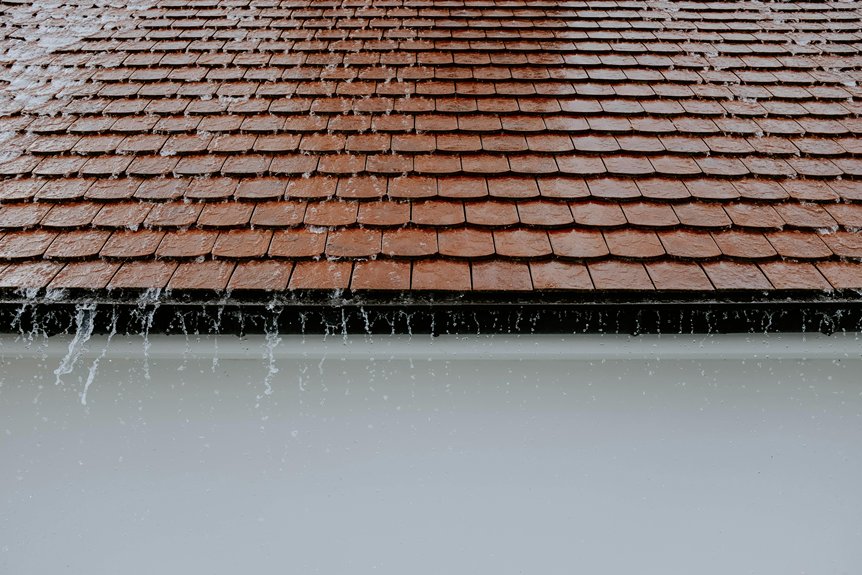When a hailstorm hits Oklahoma, your first concern might be whether your roof has sustained damage. Hail can cause more than just visible dents; it can weaken shingles and compromise your home’s protective barrier. Recognizing the signs early is vital, but knowing when to replace your roof can be complicated. Understanding the process and your options can help you make informed decisions—something every homeowner should consider after a storm.
Recognizing Damage Caused by Hailstorms
Hailstorms can cause significant damage to your roof, often without obvious signs right away. After a storm, you should perform a thorough roof inspection to spot potential hail damage.
Look for visible clues like dented or cracked shingles, bruised areas, or asphalt granule loss, which can weaken your roof’s structure. Hail damage might also cause dents on metal fixtures or gutters.
Keep in mind that some damage isn’t immediately visible from the ground, so a professional roof inspection is vital. Catching hail damage early helps prevent leaks and further deterioration.
Don’t ignore the signs—timely inspection ensures you address issues before they become costly repairs or full roof replacements.
When to Consider a Full Roof Replacement
A full roof replacement becomes necessary when the damage from a hailstorm is extensive and can’t be effectively repaired. If your roof has sustained severe hail damage, such as widespread dents, missing shingles, or multiple areas of deterioration, a roof inspection is vital.
During the inspection, professionals assess whether the damage compromises the roof’s structural integrity or its ability to protect your home. If repairs would be temporary or insufficient, replacing the entire roof is the best option.
Consider a full replacement if hail damage has caused multiple layers of shingles to be compromised, or if the roof is nearing the end of its lifespan. Acting promptly ensures your home remains protected and prevents further issues from unresolved damage.
Navigating Insurance Claims for Storm Damage
When you’ve determined that a full roof replacement is necessary after a hailstorm, dealing with insurance claims becomes a key step in the repair process.
You should start by documenting the hail impact on your roof with photos and detailed notes.
Review your insurance policies carefully to understand coverage limits and specific provisions for storm damage.
Contact your insurance provider promptly to report the damage and schedule an inspection.
Be prepared to provide evidence of the hail impact and any related damages.
During the claims process, stay organized with records of all communications and documents.
Remember, insurers might scrutinize claims closely, so clear evidence of storm damage can help facilitate a smooth process.
Ultimately, understanding your policies and documenting damage effectively are crucial to navigating insurance claims successfully.
Selecting the Right Roofing Contractor in Oklahoma
Choosing the right roofing contractor in Oklahoma is essential to guarantee your storm damage repairs are completed properly and last for years. Start by verifying that the contractor has proper licensing, ensuring they meet state requirements and have the necessary credentials. Additionally, select a contractor known for customer satisfaction and timely assistance, as this indicates a commitment to quality service. Ask for references and review their past work to gauge quality. It’s also important to discuss roofing materials upfront; a reputable contractor will recommend durable options suited for Oklahoma’s weather. Avoid contractors who push low-quality materials or avoid licensing checks. A reliable contractor will be transparent about their licensing, experience, and the roofing materials they use. Taking these steps helps protect your investment, ensures a quality job, and gives you peace of mind that your roof will withstand future storms.
The Roof Replacement Process Step-by-Step
Replacing your roof after hail damage involves a clear, step-by-step process to guarantee quality and durability. First, a professional inspection assesses the extent of damage, including the roof’s structure and shingles.
Next, you’ll choose the new roofing materials, considering options like impact-resistant shingles. During installation, the old roof is carefully removed, and any damaged decking is repaired. This may include gutter replacement to ensure proper drainage.
If you have solar panels, they’re temporarily removed and reinstalled after the new roof is in place. Once the new roofing is installed, a thorough inspection confirms everything’s secure.
Finally, the contractor cleans the site, and you review the work. Following this process ensures your roof is resilient and ready to withstand future storms.
Preventive Measures and Maintenance Tips
Proactively maintaining your roof can considerably extend its lifespan and reduce the risk of costly damage from future storms. Start by inspecting your roof regularly, especially after hail or severe weather, to catch minor issues early.
Consider investing in hail resistant materials or storm proof roofing to better withstand impacts. Keep gutters clear to prevent water buildup, which can weaken your roof’s structure. Trim overhanging branches that might cause damage during storms.
Schedule professional inspections annually to identify potential vulnerabilities before they become major problems. Applying protective coatings can also add an extra layer of defense.
Conclusion
After a hailstorm, don’t wait to assess your roof. Act quickly to spot damage, work with experienced contractors, and navigate insurance claims smoothly. Replacing your roof promptly protects your home from leaks, structural issues, and further deterioration. Staying proactive guarantees your property stays safe and maintains its value. Remember, timely action is key to long-lasting protection—so prioritize your roof’s health and get it inspected and repaired without delay. For more information on how to schedule your free roof inspection, call us at (405) 543-2920 or visit us online at Top View Roofing.











